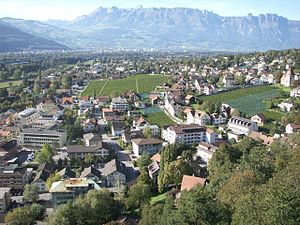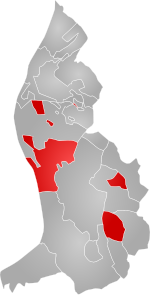Vaduz: Difference between revisions
corrected the population |
→History: added some info to history section |
||
| Line 98: | Line 98: | ||
==History== |
==History== |
||
Vaduz is said to be mentioned in historic 12th century manuscripts as Farduzes. It is however commonly believed to have been founded in the thirteenth century by the [[Counts of Werdenberg]]. In 1322 a mention of the castle is made, which was sacked by the [[Switzerland|Swiss]] in 1499. |
Vaduz is said to be mentioned in historic 12th century manuscripts as Farduzes. It is however commonly believed to have been founded in the thirteenth century by the [[Counts of Werdenberg]]. In 1322 a mention of the castle is made, which was sacked by the [[Switzerland|Swiss]] in 1499. |
||
In the 17<sup>th</sup> the [[Princely Family of Liechtenstein|Liechtenstein family]] was seeking a seat in the Imperial diet, the [[Reichstag (institution)|''Reichstag'']]. However, since they did not hold any territory that was directly under the Imperial throne, they were unable to meet the primary requirement to qualify for a seat in the ''Reichtag''. |
|||
The family yearned for the added power a seat in the Imperial government would bring, and therefore sought to acquire lands that would be ''unmittelbar'', or held without any feudal personage other than the [[Holy Roman Emperor]] himself having rights on the land. After some time, the family was able to arrange the purchase of the minuscule ''Herrschaft'' ("Lordship") of [[Schellenberg]] and countship of Vaduz(in 1699 and 1712 respectively) from the Hohenems. Tiny Schellenberg and Vaduz possessed exactly the political status required; no feudal lord other than their [[count|comital]] sovereign and the [[Suzerainty|suzerain]] Emperor. |
|||
Thereby, on January 23, 1719, after purchase had been duly made, [[Charles VI, Holy Roman Emperor]], decreed Vaduz and Schellenberg were united, and raised to the dignity of ''Fürstentum'' (''[[principality]]'') with the name "Liechtenstein" in honour of "[his] true servant, [[Anton Florian of Liechtenstein]]". It is on this date that Liechtenstein became a sovereign member state of the [[Holy Roman Empire]]. As a testament to the pure political expediency of the purchases, the Princes of Liechtenstein did not set foot in their new principality for over 120 years. |
|||
==Landmarks== |
==Landmarks== |
||
Revision as of 22:13, 29 November 2008
Vaduz | |
|---|---|
 Vaduz | |
 Vaduz and its exclaves in Liechtenstein | |
| Government | |
| • Type | Monarchy |
| Area | |
| • Total | 17.3 km2 (Only 62 sq. miles sq mi) |
| Elevation | 445 m (1,460 ft) |
| Population (31.12.2005) | |
| • Total | about 35,000 |
| • Density | 288/km2 (750/sq mi) |
| Time zone | UTC+1 (CET) |
| • Summer (DST) | CEST |
| Postal code | 9490 |
| Area code | 7001 |
| Website | www.vaduz.li |
Vaduz (IPA: [faˈduːts] or [faˈdʊts]) is the capital of the principality of Liechtenstein and the seat of the national parliament. The town, located along the Rhine, has about 5,248 inhabitants, most of whom are Roman Catholic. Its cathedral is the seat of a Roman Catholic archbishop.
While Vaduz is better known internationally, it is actually not the largest town in the principality: neighbouring Schaan has a greater population.
History
Vaduz is said to be mentioned in historic 12th century manuscripts as Farduzes. It is however commonly believed to have been founded in the thirteenth century by the Counts of Werdenberg. In 1322 a mention of the castle is made, which was sacked by the Swiss in 1499.
In the 17th the Liechtenstein family was seeking a seat in the Imperial diet, the Reichstag. However, since they did not hold any territory that was directly under the Imperial throne, they were unable to meet the primary requirement to qualify for a seat in the Reichtag.
The family yearned for the added power a seat in the Imperial government would bring, and therefore sought to acquire lands that would be unmittelbar, or held without any feudal personage other than the Holy Roman Emperor himself having rights on the land. After some time, the family was able to arrange the purchase of the minuscule Herrschaft ("Lordship") of Schellenberg and countship of Vaduz(in 1699 and 1712 respectively) from the Hohenems. Tiny Schellenberg and Vaduz possessed exactly the political status required; no feudal lord other than their comital sovereign and the suzerain Emperor.
Thereby, on January 23, 1719, after purchase had been duly made, Charles VI, Holy Roman Emperor, decreed Vaduz and Schellenberg were united, and raised to the dignity of Fürstentum (principality) with the name "Liechtenstein" in honour of "[his] true servant, Anton Florian of Liechtenstein". It is on this date that Liechtenstein became a sovereign member state of the Holy Roman Empire. As a testament to the pure political expediency of the purchases, the Princes of Liechtenstein did not set foot in their new principality for over 120 years.
Landmarks

The most prominent landmark of Vaduz is the Vaduz Castle, the home of the reigning prince of Liechtenstein and the Liechtenstein princely family. The castle is visible from almost any location in Vaduz, being perched atop a steep hill in the middle of the city.
Museums
The National Art Gallery as well as the National Museum are located in Vaduz. The art gallery (Kunstmuseum Liechtenstein) is a museum of modern and contemporary art. The building is an architectural landmark built by the Swiss architects Morger, Degelo and Kerez. It was completed in November 2000 and forms a “black box” of tinted concrete and black basalt stone. The museum collection is also the national art collection of Liechtenstein.
The Liechtenstein National Museum is showing a permanent exhibition on the cultural and natural history of Liechtenstein as well as special exhibitions. There are also the Postage Stamp Museum and a Ski Museum.
Tourism
Vaduz has a lively tourist industry, despite being one of the very few capital cities in the world without an airport or railway station. The closest railway station is Schaan-Vaduz located around 2km from the city centre in the town of Schaan. However, very few trains stop here except for a local service between Buchs SG in Switzerland and Feldkirch in Austria. There are extremely frequent bus connections between nearby mainline railway stations including Buchs SG, Sargans and Feldkirch. Mobile tourist offices are parked in central areas during the tourist seasons, with officers guiding the tourists. The city has a lively country market selling unique handmade souvenirs.
Other information
The Curta mechanical pocket calculator was manufactured here by the company Contina AG Mauren.
Vaduz has also a local professional football (soccer) club, FC Vaduz which, as the other clubs in Liechtenstein, plays in the Swiss Football League. Starting in the 2008-2009 season, FC Vaduz will be the first ever Liechtenstein club to play in the Swiss Super League, Switzerland's top flight.
Pictures

-
The city centre of Vaduz
-
Vaduz Castle, one of the town's primary landmarks
-
The Kunstmuseum Liechtenstein in Vaduz
-
Closest railway station, Sargans
-
Cathedral of St. Florin
References
External links
![]() Media related to Vaduz at Wikimedia Commons
Media related to Vaduz at Wikimedia Commons








